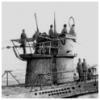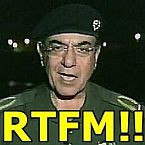morleron1225
Posts: 118
Joined: 12/29/2006
Status: offline

|
quote:
ORIGINAL: ColinWright
About the rails I have the following reactions.
1. The job of destroying them probably wouldn't go to combat units in the first place. After all, the game mechanics are such that the advancing player 'damages' the rail line by moving into the hex -- but ninety nine times out of a hundred, it would actually be the owning player that would want to destroy it.
2. The scenario designer can set the probability that an ownership change will 'damage' the railroad.
3. 'Rail lines' are starting to become an abstraction with me -- like 'trucks.' I'm beginning to think of them as 'potential major supply conduits.' Like, I'd calmly lay a 'rail line' right from Tunis to Alexandria (depending on the other parameters I set for the scenario.) It's more important how much supply could move along a given corridor than whether or not there was actually a choo-choo. From this it follows that any 'damage' is an abstraction as well.
Rail lines vary a lot in capacity anyway. The narrow gauge Hejaz railway was still running as far as Ma'an or something in World War Two -- but I bet it hadn't a tenth (or even a hundredth) of the capacity of the trunk line from Cairo to Alexandria. Then too, technically one would want all kinds of partial damage -- like that railway the Afrika Korps was able to sort of use. On this topic, I've also started representing a lot of rails as 'damaged' from the start if I've a low opinion of their capacity as-is. The player will have to invest some 'rail repair' resources if he wants to make the route into a major supply conduit.
Really, the rails (and their chance of being damaged) are best thought of as part of the designers' tool kit to get whatever effect he's after. I certainly wouldn't want the mechanism governing their function determined by how long it would actually take to wreck the local SP tracks.
Hi Colin,
I think that you are correct in some regards, not so much in others. Yes, the actual destruction of the railroads was, generally, carried out by rear area units not by combat units per se. That said, a couple of things come to mind. We already have in the game the type of units that would have performed this work - the rail repair units (on the flip-side, look closely  ). Why not allow them to undertake the work either at some movement penalty or with a decreasing chance of success per hex to be destroyed (that might get tiresome, maybe do it automatically with some pre-set flag?). If a combat unit is tasked to destroy the rail then I can see one of two choices (maybe both under some conditions) - either the destruction is not as thorough, giving the opponent's rail repair units a better chance of fixing things, or do the job thoroughly with a higher movement penalty. ). Why not allow them to undertake the work either at some movement penalty or with a decreasing chance of success per hex to be destroyed (that might get tiresome, maybe do it automatically with some pre-set flag?). If a combat unit is tasked to destroy the rail then I can see one of two choices (maybe both under some conditions) - either the destruction is not as thorough, giving the opponent's rail repair units a better chance of fixing things, or do the job thoroughly with a higher movement penalty.
Yes, scenario designers can set the chance that rails are damaged with ownership change. To me this represents more the "collateral damage" incidentally inflicted by combat rather than the deliberate destruction we're discussing.
The rail lines do represent an abstraction of sorts in that we don't actually take care of scheduling train movements. However, they also represent physical assets which can be destroyed and rendered unusable in a way that regular roads cannot, i.e., even if you rip up all the concrete on a road the "road" is still there and immediately usable to some degree, albeit with lower capacity and speed than with a well maintained road. In that sense rails are much different in that ripping up the ties (sleepers to those of you across the pond), removing the rails, etc. renders the railroad unusable as such until repairs are made - trains can't move without rails to run on.
Rail lines do indeed vary greatly in capacity. There are two main factors that affect that - rail gauge and loading gauge. Rail gauge is the distance between the rails - as most people know. However, loading gauge is, in some ways more important. For instance, the standard rail gauge in the U.S. and Great Britain are the same, 4' 8 1/2". However, the loading gauge is considerably larger in the U.S. than in G.B.. This allows U.S. railroads to run larger cars, which have higher capacities than the railroads in G.B.. Thus, for any given number or trains U.S. railroads can handle more tonnage than railroads in G.B.. However, that's the sort of detail that we don't need to concern ourselves with in TOAW - thank God. The main difference between the rail lines you mention in North Africa arose from the double-tracking of the main line between Cairo and Alexandria; a factor which roughly triples (or more) the capacity of a given line, depending on the type of signaling and control systems involved. That plus the fact that the RAF more-or-less bombed the line in Libya into oblivion at every opportunity made a big difference in the supply capabilities of the two roads. I suppose that there could be a design switch which would allow scenario designers to take that sort of thing into account by increasing the supply levels for double-tracked lines vs. single track, but I'm not sure we want to get involved to that level with TOAW.
While I agree that rail damage chances are part of the scenario designer's toolbox I think I failed to make my reasoning clear in my initial post. My main issue is that it seems unreasonable to me that units, be they combat or rear echelon, can zip along a railroad madly ripping things up with no movement penalty, yet it takes a rail repair unit at least one turn to repair a single hex. Thus, a retreating defender can ensure that an attacker might need weeks, maybe months, to restore a line to service. While there is some truth in that, witness the Germans in Operation Barbarossa, in many ways the rate of repair (for at least minimal service) is/was more dependent on the number of rail repair units a given force had available. The Germans failed to allocate sufficient assets to that task in Barbarossa and paid the price for their error. Perhaps the best way to handle the discrepancy would be to allow rail repair units to repair more than one hex per turn with a decreasing chance of success per hex. That would probably be easier to implement (though I really don't know) than my earlier suggestion.
As I mentioned originally, this is just a small nit and certainly does not ruin the game, for me at least. TOAW is, IMHO, the best wargame of its type ever. But to keep it that way we should all be looking for ways of improving it and this item is my small attempt to do so.  Keep up the good work and maybe, when TOAW IV comes out we'll have a game so capable we'll never play anything else. Wait, that's practically the case with me now. Keep up the good work and maybe, when TOAW IV comes out we'll have a game so capable we'll never play anything else. Wait, that's practically the case with me now.
Just my $.02,
Ron
_____________________________
Free men do not ask permission to bear arms.
GnuPG public key available at: pgp.mit.edu
|
 Printable Version
Printable Version
















 Keep up the good work and maybe, when TOAW IV comes out we'll have a game so capable we'll never play anything else. Wait, that's practically the case with me now.
Keep up the good work and maybe, when TOAW IV comes out we'll have a game so capable we'll never play anything else. Wait, that's practically the case with me now.  New Messages
New Messages No New Messages
No New Messages Hot Topic w/ New Messages
Hot Topic w/ New Messages Hot Topic w/o New Messages
Hot Topic w/o New Messages Locked w/ New Messages
Locked w/ New Messages Locked w/o New Messages
Locked w/o New Messages Post New Thread
Post New Thread